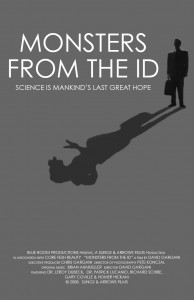 As regular readers of this blog are aware, I am a huge fan of 1950s science fiction/horror, those films that had an early formative influence on my love for the fantastic. In reading through a science fiction magazine today I came across a documentary that makes interesting use of these films as it argues for their positive impact on our culture. It is titled Monsters From the Id: Science is Mankind’s Last Great Hope. The documentary’s website provides this synopsis:
As regular readers of this blog are aware, I am a huge fan of 1950s science fiction/horror, those films that had an early formative influence on my love for the fantastic. In reading through a science fiction magazine today I came across a documentary that makes interesting use of these films as it argues for their positive impact on our culture. It is titled Monsters From the Id: Science is Mankind’s Last Great Hope. The documentary’s website provides this synopsis:
The 1950’s was an idealistic time in American History, filled with hope, opportunity, and wonder. It was also, “The Atomic Age”, where new technology promised to both save humanity as well as put it in jeopardy. All of these factors gave birth to one of the most prolific genres in film history, 1950’s Science Fiction Cinema. More then just bug eyed monsters and little green men, 1950’s Sci-fi Cinema provided science inspiration for millions of eager youths across the country.
While monsters and invaders of many forms have always existed in cinema, it wasn’t until the 1950’s that Hollywood created a new character. This new character is the Modern Scientist. His predecessor, the Mad Scientist was evil and intent on using science for his own personal gains, no matter the outcome. With atomic energy now a part of the world everyone lived in, this type of scientist was more dangerous then ever. Instead, the Modern Scientist was created to calm the fears associated with the atomic age. This new American Citizen was brilliant, polite, thoughtful, charming and not surprisingly very good looking. Just as science took the lead in much of the news of the 1950’s, the scientist became Hollywood’s new leading man and a role model for young boys and girls across America.
Although Hollywood was mostly interested in selling tickets and popcorn, there were others that understood the power of these films and the influence they had on society. Soon filmmakers like Walt Disney and George Pal started collaborating with famed rockets scientists, Werner Von Braun and Willie Ley in an effort to energize the American public and peak their interest in manned space travel. What followed were technically accurate sci-fi films that both entertained and educated the next generation of scientists in America. However as progress marched on, it was a real life event that finally sent the wheels into motion.
On October 4, 1957 the Russians provided the spark in the form of the first man made satellite, Sputnik. America immediately went into a panic and suddenly science and the need to match the Russians in space became a top priority. From that point forward, the American Government took exploratory space flight seriously and the first man they called was Werner Von Braun. With the help of science fairs and a revamped science curriculum an inspired population worked toward one of the greatest achievement of mankind, spaceflight. Along the way, Sci-Fi cinema and science fact worked together to change the lives of American Students in ways we only dreamed of before.
Through the use of the movies themselves and expert analysis from scientists and educators, Monsters From The Id weaves the intersecting themes of over thirty classic films in order to tell the untold story of the Modern Scientist and his role in inspiring a nation. The film continues to explore the psychological and cultural impact of 1950’s Sci-Fi cinema and asks, “where is science inspiration found today?”
As mentioned in the introduction to this post, finding inspiration for careers in the sciences through 1950s science fiction/horror is indeed an unusual and unique approach. But the positive aspects of science and the scientist in these films must be held in tension with the science run amok and “mad scientist” elements also frequently found in these films, and with the anti-rationalizing element in them as discussed by Mark Jancovich in Rational Fears: American Horror in the 1950s (Manchester University Press, 1996).
Related post:





There are no responses yet